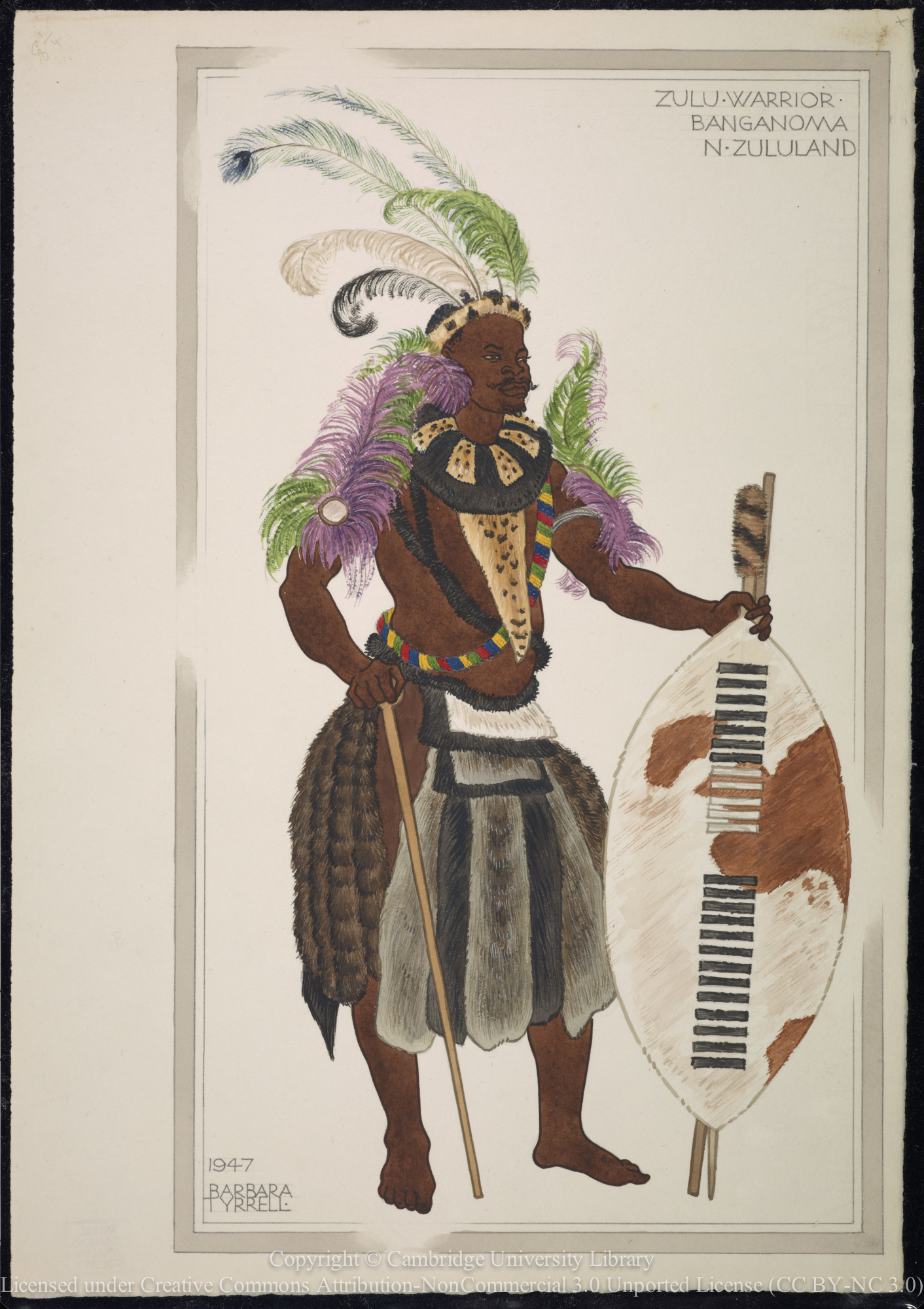Tyrrell, Barbara Eleanor Harcourt, 1912 (artist)
Found in 50 Collections and/or Records:
'Mathai Thai', Mamathes, Basutoland [Lesotho], 1948
'The Basuto sun hat is of open weave, providing plenty of air space, and a moving pattern of shade on the head. It is a favourite with both ·men and women and assumes many shapes. Facial markings were common to Basuto women formerly, but are now seldom seen. A woman wears her blanket pinned in front, a man's· blanket being pinned on the right shoulder. Aprons and many-tucked long skirts are typical wear among Basuto women, and reflect the missionary influence of Victorian days.'
Mcwasho dress, Oshoek, Swaziland [Eswatini], 1949
'Mdinega Magutywa', Fingo matron, Peddie, 1948
Motherhood, Leribe, Basutoland [Lesotho], 1948
In Basutoland, (as elsewhere in Africa), the infant is carried on the back and incorporated in the folds of its mother's gay blanket. The infant head is always clean shaven, and the entire baby is kept shining with vaseline (formerly animal fat), a protection against summer sun and winter frost. This mother's dress echoes the Victorian missionary era in the series of tucked aprons and petticoats. Her purchase at the local trading store is ‘tickey paraffin’, a constant need.
[Photographs of the peoples of southern Africa]
Pondo girl, Libode, Pondoland [Eastern Cape], 1947
'Blue and white is the beadwork of Pondoland and red ochre the colour of everyday wear. Unmarried girls do not wear the ceremonial white, nor do they attend parties, celebrations, beer drinks. The bead head band of this typical design is usually worn by girls and boys of courting age, and may be interchanged as tokens of affection. The exchange of love tokens is a popular Pondo custom. Scarification of the face in the manner illustrated, is also customary.'
Pondo youth, Libode, Pondoland [Eastern Cape], 1947
'Traditionally, when a young Pondo man seats himself, his legs must be straight out along the ground, his blanket draped down torso and legs. Draperies are ochred deep red and beadwork is of blue and white. Regular dress comprises hip cloth kept in place by a series of beaded belts; a blanket; a twist of cloth on the hair which is finely plaited in neat ‘ducks' tails’. Sparring with sticks is the most popular pastime of young Pondo manhood.'
Recent bride, Amangwane, Drakensberg, 1949
'Soncani Amenziwe', Xosa matron, Gonubie, Ciskei [Eastern Cape], 1948
Swazi bride, Mbabane, Swaziland [Eswatini], 1949
Swazi chief, Mbabane, Swaziland [Eswatini], 1949
Swazi dandy, Gollel area, Swaziland [Eswatini], 1949
Swazi girl, Mbabane, Swaziland [Eswatini], 1949
Swazi matron, Nzoka area, Swaziland [Eswatini], 1949
Swazi warrior, Oshoek, Swaziland [Eswatini], 1949
Swazi widow, Mbabane, Swaziland [Eswatini], 1950
Victory blanket, Leribe, Basutoland [Lesotho], 1948
'Viseko Msobomvu', Xosa girl, Kingwilliamstown [Qonce, Eastern Cape], 1948
Xosa girl, Gonubie, E. Province [Eastern Cape], 1949
Xosa man, Gonubie, Ciskei [Eastern Cape], 1948
Xosa motherhood, Grahamstown, Eastern Province [Makhanda, Eastern Cape], 1948
Xosa witch doctor, Kingwilliamstown, E. Province [Qonce, Eastern Cape] [historic title], 1948
Zulu councillor, Mahashini, Zululand [KwaZulu-Natal], 1949
Zulu motherhood, Shongweni, Natal [KwaZulu-Natal], 1949

Zulu warrior, Banganoma, Zululand [KwaZulu-Natal], 1947
Additional filters:
- Type
- Archival Object 49
- Collection 1
- Subject
- Africa (continent) 48
- South Africa (nation) 42
- Natal (inhabited place) 6
- Costume 1
- Cultural anthropology 1
